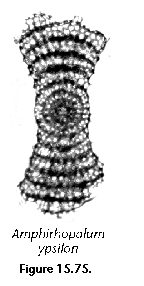 |
Amphirhopalum ypsilon Haeckel (Figure 2R, 15.71, 15.75). Shell with two opposite chambered
arms, one of them may be bifurcated distally, in which
case the shell outline becomes trigonal. Total length:
200-300 Ám. Ref: Nigrini and Moore
(1979). 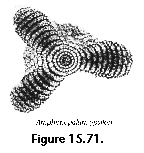
|
 |
Dictyocoryne profunda Ehrenberg (Figure 2Q, 15.68) [=Hymeniastrum euclidis].
Three spongy, unchambered arms radiating at equal or
almost equal angles from a central disc. Length of arms
(from center of shell): 130-150 Ám. Ref: Nigrini and Moore
(1979).
|
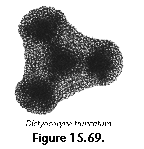 |
Dictyocoryne truncatum (Ehrenberg) (Figure 15.69). Very similar to D. profunda
(and probably synonymous with it: intergrading specimens
are very common); differs in having much broader arms and
usually a well developed patagium (Figure 2Q, 2R). Length
of arms (from center of shell): ca. 130 Ám. Ref: Nigrini and Moore
(1979).
|
 |
Euchitonia elegans/furcata (Ehrenberg) group? (Figure 15.70) [=?Euchitonia furcata, Euchitonia
elegans]. Differs from D. profunda in that
the three arms are more slender, longer, and their
orientation defines two larger angles and one smaller
one. E. elegans intergrades smoothly with Euchitonia
furcata; end members differ in that distal tips of
arms taper in E. elegans (Figure 15.70c), while in
E. furcata their terminations are club-shaped and
more blunt (Figure 15.70a, b). Length of arms (from
center of shell): 150-300 Ám. Ref: Nigrini and Moore
(1979).
|
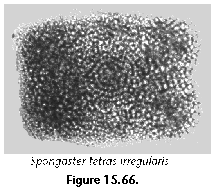 |
Spongaster tetras Ehrenberg irregularis
Nigrini (Figure 15.66). Generally similar to S. tetras
tetras, except that shell is less regular, angles
between "arms" are uneven, and outline is an
elongated rectange (rather than a square). Length of
longer side: 140-260 Ám. Ref: Nigrini and Moore
(1979).
|
 |
Spongaster tetras tetras Ehrenberg (Figure 15.67). Shell outline rectangular with
rounded corners; denser spongy meshwork defines four
equidistant pear-shaped "arms" radiating from
the center. Side of rectangle: 150-300 Ám. Ref: Nigrini and Moore
(1979).
|
 |
Spongocore cylindrica Haeckel (Figure 15.74) [=Spongocore puella, Spongocore
diplocylindrica]. Spongy cylinder with or without
protruding spines and mantle, often with two slight
constrictions. Total length: 200-360 Ám. Ref: Benson (1966).
|
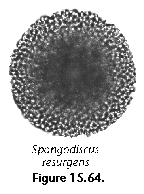 |
Spongodiscus resurgens Ehrenberg (Figure 15.64). Spongy biconvex disc with no
discernible structure, without spines on edges or
surfaces of disc. Diameter of disc: 100-400 Ám. Ref: Boltovskoy and
Riedel (1980).
|
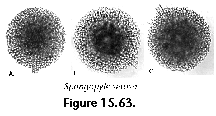 |
Spongopyle setosa Dreyer (Figure 2N, 15.63) [=Spongopyle osculosa].
Similar to S. resurgens, except for the presence
of a tubular, spiny or notched pylome on the margin.
Diameter of disc: 100-300 Ám. Ref: Riedel (1958).
|
 |
Spongotrochus glacialis Popofsky (Figure 2I, 15.61). Similar to S. resurgens,
except for the presence of spines on the surfaces and/or
on the margins of the disc. Can have an inconspicuous
pylome. Diameter of disc (without spines): 100-500 Ám.
Ref: Riedel (1958), Petrushevskaya (1967).
|
 |
Spongurus pylomaticus Riedel (Figure 15.72). Shell subcylindrical or elongate
ellipsoidal, inner dense spongy meshwork surrounded by
looser mantle, surface covered with bristle-like spines,
with a pylome at one of the poles. Length: 70-250 Ám.
Ref: Riedel (1958), Petrushevskaya (1967).
|
 |
Spongurus spp. group? (Figure 15.73). Irregular, oval-elongate spongy
mass, sometimes with concentric or spiral rings, with
spines protruding at the poles. Length: ca. 100-150 Ám.
Ref: Petrushevskaya (1967).
|
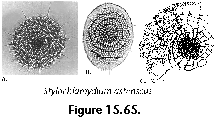 |
Stylochlamydium asteriscus Haeckel (Figure 2P, 15.65) [=?Stylochlamydium venustum].
Biconvex spongy disc more or less clearly partitioned
into chambers by circular or spiral, continuous or
broken, and radial bands. Both surfaces covered by a thin
porous sieve plate which can extend beyond the central
spongy mass. With or without protruding spines. Very
similar morphotypes with an oval outline and a pylome
have been cited under the name Stylochlamydium
venustum Bailey (Figure 15.65b). Diameter of disc:
150-350 Ám. Ref: Boltovskoy and
Vrba (1988).
|
 |
Stylodictya aculeata Jorgensen (Figure 15.62). Flat disk not thickened in the
center, with clearly defined circular concentric rings,
the innermost rosette-shaped. Diameter of disc: ca. 150
Ám. Ref: Petrushevskaya (1967), Boltovskoy and
Vrba (1988).
|
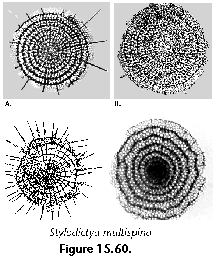 |
Stylodictya multispina Haeckel (Figure 2O; 15.60) [=Stylodictya validispina, Stylodictya
tenuispina]. Similar to S. aculeata, except
that all rings are circular to subcircular (rather than
rosette-shaped), center may be thickened (darker), and
usually with marginal spines. Diameter of disc: 100-200
Ám. Ref: Boltovskoy and
Vrba (1988).
|















